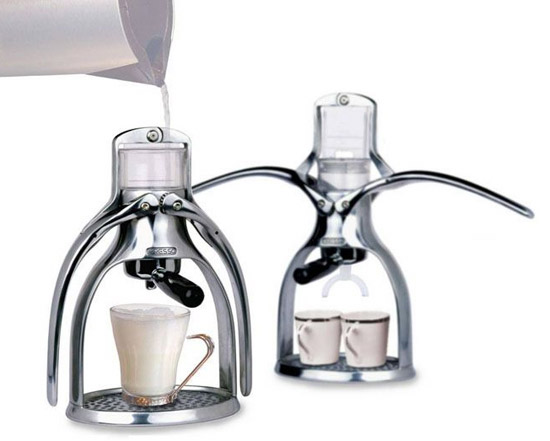Coffeemakers or coffee machines are cooking appliances used to brew coffee. While there are many different types of coffeemakers applying a number of different brewing principles, in the more common machines, coffee dirts are placed in a clause or metal filter inside a run, which is set over a glass or ceramic coffee utensil , a cooking flowerpot in the kettle pedigree. Cold sea is run into a separate assembly, which is then heated up to the boiling point, and sent into the spout. This is also called automatic drip-brew .
eco espresso maker

For hundreds of years, making a container of coffee was a simple process. Cooked and sand coffee beans were placed in a jackpot or pan, to which hot water was included, must be accompanied by connect of a lid to start the infusion process. Bowls were designed specifically for brewing coffee, all with the purpose of trying to catch the coffee dirts before the coffee is extend. Typical blueprints boast a potty with a flat expanded tush to catch decline grimes and a sharp-witted passage gush that catches the moving grinds. Other designs quirk a wide hump in the middle of the toilet to catch clays when coffee is poured.
Mr. Coffee Brixia 3Piece 6 Cup Stove Top Espresso Maker Walmart.com

In France, in about 1710, the Infusion brewing process was introduced. This involved submersing the dirt coffee, often enclosed in a linen baggage, in hot water and telling it steep or "infuse" until the desired persuasivenes brew was reached. Nevertheless, throughout the 19 th and even the early 20 th centuries, it was considered adequate to add sand coffee to hot water in a pot or pan, boil it until it reeked right, and move the drink into a cup.
Coffee Maker Hand Pressure Portable Espresso Machinein Coffee Makers

There were lots of inventions from France in the late 18 th century. With assistance from Jean-Baptiste de Belloy, the Archbishop of Paris, the relevant recommendations that coffee shall not be required to steamed gained credence. The first modern technique for quickening coffee employing a coffee filter--drip brewing--is more than 125 years old, and its designing had changed little. The biggin , are produced in France ca. 1780, was a two-level container seeing coffee in a cloth sock in an upper locker into which sea was led, to drain through cracks in the bottom of the locker into the coffee bowl below. Coffee was then granted from a gush on the side of the jackpot. The excellence of the brewed coffee depended on the dimensions of the clays- very coarse and the coffee was strong; very well prepared and the high seas has not given an opportunity to drip the filter. A major difficulty with this approach was that the goody of the cloth filter- whether cotton, burlap or an old-fashioned sock- transferred to the delicacy of the coffee. Around the same period, a French discoverer developed the" pumping percolator", in which simmering sea in a foot enclosure dominances itself up a tube and then seeps( seeps) through the sand coffee back into the bottom assembly. Among other French inventions, Count Rumford, an eccentric American scientist find ourselves in Paris, developed a French Drip Pot with an isolating ocean coating to keep the coffee red-hot. Likewise, the first metal filter was designed and patented by French inventor.
How to Clean a Cuisinart Coffee Maker Kitchen Latest Trends

EmoticonEmoticon